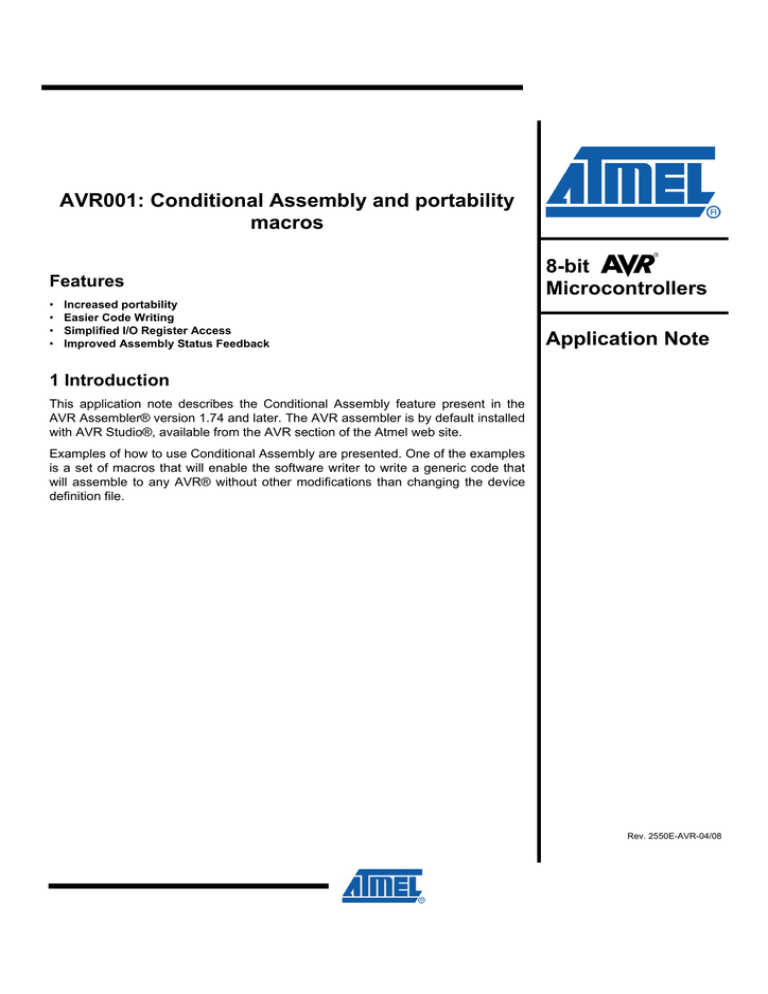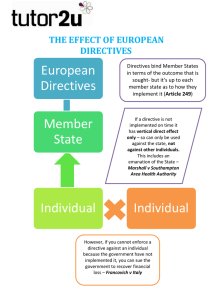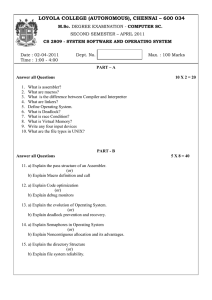
AVR001: Conditional Assembly and portability
macros
Features
•
•
•
•
Increased portability
Easier Code Writing
Simplified I/O Register Access
Improved Assembly Status Feedback
8-bit
Microcontrollers
Application Note
1 Introduction
This application note describes the Conditional Assembly feature present in the
AVR Assembler® version 1.74 and later. The AVR assembler is by default installed
with AVR Studio®, available from the AVR section of the Atmel web site.
Examples of how to use Conditional Assembly are presented. One of the examples
is a set of macros that will enable the software writer to write a generic code that
will assemble to any AVR® without other modifications than changing the device
definition file.
Rev. 2550E-AVR-04/08
2 Theory of operation
Conditional Assembly (CA) was introduced in the AVR assembler in version 1.74. CA
is based on a series of directives similar to the preprocessor directives available in C.
Since version 2.0, AVR assembler also has a preprocessor modeled after the C
preprocessor. This allows for, e.g., C header files for devices to be used.
The difference between the regular preprocessor and the CA directives is that the
latter are evaluated at compile time, and may therefore be used as a means of
overloading macros. The regular preprocessor may be used for, e.g., configuration
and selecting device dependent code, although this can be done with the CA
directives as well. (This application note deals with CA directives only.)
Please see AVR Studio help on Assembler for a complete list of directives.
2.1 Conditional Assembly
The assembler evaluates a CA directive expression at compile-time and determines if
the code enclosed by the CA directive is to be included or not.
A list of Conditional Assembly directives is presented in Table 2-1.
Table 2-1. Conditional Assembly Directives
2
Directive
Description
.ifdef <symbol>
Includes the code present between the .ifdef and the
corresponding .else or .endif if the symbol is defined.
Only symbols declared by .EQU or .SET are evaluated
by .ifdef; symbols defined by the .def directives are
treated differently by the assembler and cannot be used
with .ifdef.
.ifndef <symbol>
Includes the code present between the .ifndef and the
corresponding .else or .endif if the symbol is not
defined. Only symbols declared by .EQU or .SET are
evaluated by .ifndef; symbols defined by the .def
directives are treated differently by the assembler and
cannot be used with .ifndef.
.if <expression>
Includes the code present between the .if and the
corresponding .else, .elif, or .endif if the expression
evaluates to a value different from zero (true).
.elif <expression>
A .elif must be preceded by .if. It will include the code
present between the .elif and the corresponding .else,
.elif, or .endif if the expression evaluates to a value
different from zero (true).
.else
A .else must be preceded by a .if or .elif. Will include
the code present between the .else and the
corresponding .endif if the expression specified for the
corresponding .if or .elif evaluates to zero (false).
.endif
A .endif must be preceded by a .ifdef, .ifndef, .if, .else or
.elif. The .endif defines the end of scope for the
corresponding .ifdef, .ifndef, .if, .else or .elif.
AVR001
2550E-AVR-04/08
AVR001
The directives can be nested in up to 5 levels. CA directives can be combined with
the .MACRO directive to make macros assemble differently depending on the
enclosed CA directives. This is used in the example code for this application note.
2.2 Debugging Directives
When developing code it is useful with different types of feedback at assembly-time.
For this purpose two new directives have been added: one that outputs a message to
the message window if encountered and one that issues an error (accompanied with
an error message). The debugging directives are described in Table 2-2.
Table 2-2. Debugging Directives
Directive
Description
.message "string”
If the .message directive is encountered when code is
assembled, the "string" is written to the message
window.
.error "string”
If the .error directive is encountered when code is
assembled, an assembly error is issued and the "string"
is written to the message window.
These directives can be combined with (e.g. AC) directives to provide information
about the assembling status. The use of the .message directives is included in the
code example for this application note. Please note that AVR Assembler 1.77.1 stops
futher assembly when encountering the .error directive.
2.3 Example 1: General usage of CA
The reuse of code modules from one project to the next can often be a great time
saver. Reusage of code modules will, without pre-processor directives or in this case
CA directives, easily result in several different versions of the code module as it
needs to be tailored for the different targets used. Using CA one version can be used
for several target devices.
As an example, consider the initialization of the I/0 pins used for UART
communication:
.EQU
ATmega128=1
;Declares the symbol ATmega128
;EQU
ATmega16=1
;Declares the symbol ATmega16
.EQU
UART =0
;UART0 or UART1
.ifdef ATmega128
.message "UART Module assembled for ATmega128."
.if UART == 0
.message "UART0 used."
sbi DDRE, PE1
;Configure TxD as output
.elif UART == 1
.message "UART0 used."
sbi DDRD, PD3
;Configure TxD as output
.else
.error "UART number not specified"
.endif
.elif ATmega16
.message "UART Module assembled for ATmega128."
3
2550E-AVR-04/08
.if UART == 0
.message "UART0 used."
sbi DDRD, PD1
;Configure TxD as output
.else
.error "UART number not specified"
.endif
.endif
As seen from the code example, a device specific initialization of (e.g. a UART) can
be contained in one file. This allows for better control of the code modules reused.
2.4 Example 2: Conditional Assembly in Macros
The code example for this application note requires the AVR Assembler version 1.77
or later to assembled correctly. The AVR assembler is included with AVR Studio,
which can be downloaded from the AVR section on the Atmel web site.
The file "macros.inc" includes a number of macros to ease bit and byte access in the
I/0 and data space. The macros are listed with comments in Table 2-3.
Table 2-3. Macros Defined in the File “macros.inc”
Macro name
Description
SETB [Address, Bit Mask, Register]
"Set Bit" - Set a bit in any location in the I/0
space. Registers that can be used are R16-R31.
CLRB [Address, Bit Mask, Register]
"Clear Bit" - Clear a bit in any location in the I/0
space. Registers that can be used are R16-R31.
SKBS [Address, Bit Mask, Register]
"Skip if Bit Set" - skip the instruction following the
macro if the bit specified by Bit Mask in any
location in the I/0 space is set.
SKBC [Address, Bit Mask, Register]
"Skip if Bit Cleared" - skip the instruction following
the macro if the bit specified by Bit Mask in any
location in the I/0 space is cleared.
STORE [Address, Register]
"Store register" - Stores the contents of a register
in a location in any location in the I/0 space.
LOAD [Register, Address]
"Load register" - Load a register with the contents
from any location in the I/0 space.
The reason for using these macros to access I/0 space (and extended I/0 space) is
that the code writer need not consider where in the I/0 space the accessed registers
are located. This would be required if the macros were not used as not all instructions
reach all addresses in the I/0 space. The advantages are therefore numerous:
•
•
•
•
The author doesn't need to know the I/0 map, just the names of the registers.
The standard definition files for register and bit names can be used.
The most code size efficient instructions are used to access a register.
The assembly code can be ported to any device without modifying the code.
2.4.1 The Set-Bit Macro
As all the macros are similar in nature only the SETB are described in details.
4
AVR001
2550E-AVR-04/08
AVR001
Three arguments are specified for the SETB macro: a destination address, a bit mask
and a register. The register is only used if the address is higher than 0x001F, but it is
recommended to specify it anyway to ensure correct assembly and best portability
opportunities.
The range of the Bit mask is verified to be between 0 and 7, if this condition is
violated an error is issued using the .error directive.
If the address is below 0x1F the SBI instruction is used to set the bit. If the Address is
between 0x1F and 0x3F IN and OUT instruction is used to access the address.
Finally, if the address is above 0x3F the LDS and STS instructions are used.
Figure 2-1 shows how the assembler handles the SETB macro using CA.
Figure 2-1. Assembling flow for CA inside SETB macro.
SETB macro
Arg 1 > 7?
Yes
Msg: "Only
values 0-7
allowed..."
Yes
lds ...
sbr ...
sts ...
Yes
in ...
sbr ...
out ...
No
Arg 0 >0x3F?
No
Arg 0 >0x1F?
No
sbi ...
End macro
2.5 Improvements
At the expense of one of the registers Y or Z the LOAD and STORE macros could be
improved to execute faster and be more code compact: If one of these registers are
reserved for indirect access the STS and LDS instructions could be replaced by STD
and LDD. As this is a constraint to the code writer this has not been added in the
present implementation.
5
2550E-AVR-04/08
Disclaimer
Headquarters
International
Atmel Corporation
2325 Orchard Parkway
San Jose, CA 95131
USA
Tel: 1(408) 441-0311
Fax: 1(408) 487-2600
Atmel Asia
Room 1219
Chinachem Golden Plaza
77 Mody Road Tsimshatsui
East Kowloon
Hong Kong
Tel: (852) 2721-9778
Fax: (852) 2722-1369
Atmel Europe
Le Krebs
8, Rue Jean-Pierre Timbaud
BP 309
78054 Saint-Quentin-enYvelines Cedex
France
Tel: (33) 1-30-60-70-00
Fax: (33) 1-30-60-71-11
Atmel Japan
9F, Tonetsu Shinkawa Bldg.
1-24-8 Shinkawa
Chuo-ku, Tokyo 104-0033
Japan
Tel: (81) 3-3523-3551
Fax: (81) 3-3523-7581
Technical Support
avr@atmel.com
Sales Contact
www.atmel.com/contacts
Product Contact
Web Site
www.atmel.com
Literature Request
www.atmel.com/literature
Disclaimer: The information in this document is provided in connection with Atmel products. No license, express or implied, by estoppel or otherwise, to any
intellectual property right is granted by this document or in connection with the sale of Atmel products. EXCEPT AS SET FORTH IN ATMEL’S TERMS AND
CONDITIONS OF SALE LOCATED ON ATMEL’S WEB SITE, ATMEL ASSUMES NO LIABILITY WHATSOEVER AND DISCLAIMS ANY EXPRESS, IMPLIED
OR STATUTORY WARRANTY RELATING TO ITS PRODUCTS INCLUDING, BUT NOT LIMITED TO, THE IMPLIED WARRANTY OF MERCHANTABILITY,
FITNESS FOR A PARTICULAR PURPOSE, OR NON-INFRINGEMENT. IN NO EVENT SHALL ATMEL BE LIABLE FOR ANY DIRECT, INDIRECT,
CONSEQUENTIAL, PUNITIVE, SPECIAL OR INCIDENTAL DAMAGES (INCLUDING, WITHOUT LIMITATION, DAMAGES FOR LOSS OF PROFITS,
BUSINESS INTERRUPTION, OR LOSS OF INFORMATION) ARISING OUT OF THE USE OR INABILITY TO USE THIS DOCUMENT, EVEN IF ATMEL HAS
BEEN ADVISED OF THE POSSIBILITY OF SUCH DAMAGES. Atmel makes no representations or warranties with respect to the accuracy or completeness of the
contents of this document and reserves the right to make changes to specifications and product descriptions at any time without notice. Atmel does not make any
commitment to update the information contained herein. Unless specifically provided otherwise, Atmel products are not suitable for, and shall not be used in,
automotive applications. Atmel’s products are not intended, authorized, or warranted for use as components in applications intended to support or sustain life.
© 2008 Atmel Corporation. All rights reserved. Atmel®, logo and combinations thereof AVR®, and others, are the registered trademarks or
trademarks of Atmel Corporation or its subsidiaries. Other terms and product names may be trademarks of others.
2550E-AVR-04/08


